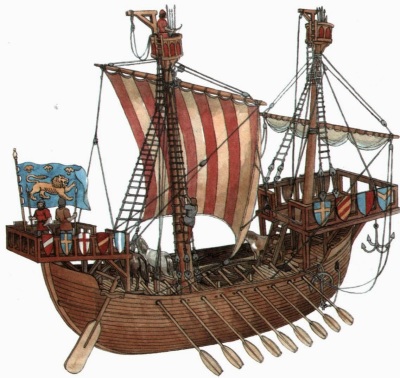A northern European cog with high sides, a straight prow, a flat keel and a single square sail. From a manuscript of ca. 1270.
Maritime power played a vital part in the Third Crusade because of the transportation of both men and supplies to the East. In addition, control of the sea was crucial in the fall of Acre in July 1191, and it enabled Richard I to recapture part of the Palestinian coast.
The Arabs only began to build warships after early Muslim rulers saw that they were needed to make conquests in the Mediterranean. They employed local experts to build and crew the fleets that defeated the Byzantines off Egypt in 654, and attacked islands such as Cyprus, Crete, Rhodes, and Sicily. In the late seventh century the Muslim governor of North Africa established shipyards at Tunis and built more than 100 ships. In the 840s a North African and Spanish Muslim fleet captured most of Sicily from Byzantium. In 904 an Arab fleet sacked Thessalonica, and throughout the tenth century Muslim ships dominated the Mediterranean. Although Muslim-owned warships were large, heavy, and slow, they were also stable and all-season vessels, unlike the Christian-owned types, which did not sail the Mediterranean in the winter. Most ships from Muslim territory operated as traders when they were not acting as warships and were hired by rulers on a freelance basis.
By the twelfth century improved western European ships, especially those of traders from the Italian cities of Venice, Genoa, and Pisa, were competing to control the Mediterranean. The most common warship was the long, narrow galley that sat low in the water and had the flexibility of oar- or sail-power, depending on the weather. The galley could be used for trade.
From 1177 Saladin began to improve the Egyptian fleet in order to defend his coasts from Christian ships and to attack ports of the Christian East. He imported timber from Europe and tried to recruit suitable crews. (In 1179 the church banned Christians from serving as captains or pilots in Muslim vessels.) Saladin’s improvements alarmed the Franks, who feared he would attack pilgrim ships and the crusader states-as he did in 1182, when at least thirty galleys unsuccessfully attacked Beirut.
After his victories of 1187 Saladin used his fleet to control the Syria-Palestine coastline. Only Admiral Margarit of Sicily resisted him in the north, while Conrad of Montferrat’s fleet at Tyre defeated him in the south. In his attempt to evade the crusader blockade of Acre during the siege of 1189-91, Saladin even disguised vessels as Christian ships (by putting pigs on board). The crusaders used ships to transport troops and supplies and to attack Muslim fortresses, erecting siege towers on ships to create mobile fighting platforms. Conrad defeated the Muslim fleet at Acre and Saladin’s naval supremacy finally ended in June 1191 when King Richard I arrived with a large fleet of warships and transports. They carried supplies up and down the coast, protected the crusaders marching along it, kept Richard in contact with coastal bases even when Saladin blocked the road, and enabled him to relieve Jaffa quickly in August 1192.
After Saladin’s death in 1193 Egypt’s rulers paid less attention to naval power, but still needed a fleet both for defense and to attack Christian settlements. Later, the Mamluk sultan Baibars I built up a fleet and in 1271 attacked Cyprus. In 1302 Egypt captured the island of Arwad from the Templars. Further north, Turkish ships raided the Greek islands, and in the fifteenth century the Ottoman Turks emerged as the greatest naval power in the Mediterranean.
